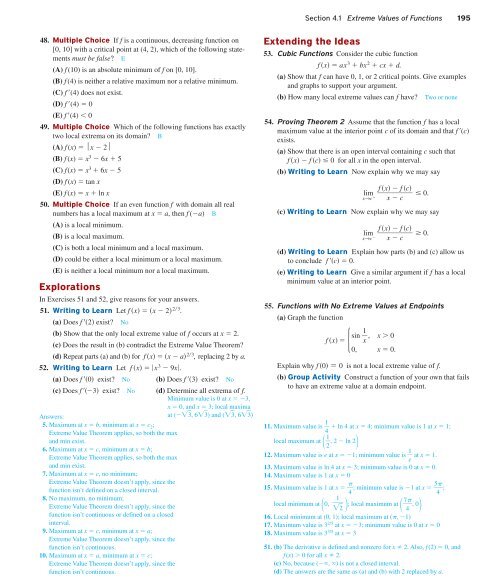5128_Ch04_pp186-260
Create successful ePaper yourself
Turn your PDF publications into a flip-book with our unique Google optimized e-Paper software.
Section 4.1 Extreme Values of Functions 195<br />
48. Multiple Choice If f is a continuous, decreasing function on<br />
[0, 10] with a critical point at (4, 2), which of the following statements<br />
must be false? E<br />
(A) f (10) is an absolute minimum of f on [0, 10].<br />
(B) f (4) is neither a relative maximum nor a relative minimum.<br />
(C) f (4) does not exist.<br />
(D) f (4) 0<br />
(E) f (4) 0<br />
49. Multiple Choice Which of the following functions has exactly<br />
two local extrema on its domain? B<br />
(A) f (x) ⏐x 2⏐<br />
(B) f (x) x 3 6x 5<br />
(C) f(x) x 3 6x 5<br />
(D) f (x) tan x<br />
(E) f (x) x ln x<br />
50. Multiple Choice If an even function f with domain all real<br />
numbers has a local maximum at x a, then f (a) B<br />
(A) is a local minimum.<br />
(B) is a local maximum.<br />
(C) is both a local minimum and a local maximum.<br />
(D) could be either a local minimum or a local maximum.<br />
(E) is neither a local minimum nor a local maximum.<br />
Explorations<br />
In Exercises 51 and 52, give reasons for your answers.<br />
51. Writing to Learn Let f x x 2 23 .<br />
(a) Does f 2 exist? No<br />
(b) Show that the only local extreme value of f occurs at x 2.<br />
(c) Does the result in (b) contradict the Extreme Value Theorem?<br />
(d) Repeat parts (a) and (b) for f x x a 23 , replacing 2 by a.<br />
52. Writing to Learn Let f x x 3 9x.<br />
(a) Does f 0 exist? No (b) Does f 3 exist? No<br />
(c) Does f 3 exist? No (d) Determine all extrema of f.<br />
Minimum value is 0 at x 3,<br />
x 0, and x 3; local maxima<br />
Answers:<br />
at (3, 63) and (3, 63)<br />
5. Maximum at x b, minimum at x c 2 ;<br />
Extreme Value Theorem applies, so both the max<br />
and min exist.<br />
6. Maximum at x c, minimum at x b;<br />
Extreme Value Theorem applies, so both the max<br />
and min exist.<br />
7. Maximum at x c, no minimum;<br />
Extreme Value Theorem doesn’t apply, since the<br />
function isn’t defined on a closed interval.<br />
8. No maximum, no minimum;<br />
Extreme Value Theorem doesn’t apply, since the<br />
function isn’t continuous or defined on a closed<br />
interval.<br />
9. Maximum at x c, minimum at x a;<br />
Extreme Value Theorem doesn’t apply, since the<br />
function isn’t continuous.<br />
10. Maximum at x a, minimum at x c;<br />
Extreme Value Theorem doesn’t apply, since the<br />
function isn’t continuous.<br />
Extending the Ideas<br />
53. Cubic Functions Consider the cubic function<br />
f x ax 3 bx 2 cx d.<br />
(a) Show that f can have 0, 1, or 2 critical points. Give examples<br />
and graphs to support your argument.<br />
(b) How many local extreme values can f have? Two or none<br />
54. Proving Theorem 2 Assume that the function f has a local<br />
maximum value at the interior point c of its domain and that f (c)<br />
exists.<br />
(a) Show that there is an open interval containing c such that<br />
f x f c 0 for all x in the open interval.<br />
(b) Writing to Learn Now explain why we may say<br />
lim<br />
x f c<br />
x→c f 0.<br />
x c<br />
(c) Writing to Learn Now explain why we may say<br />
lim<br />
x f c<br />
x→c f 0.<br />
x c<br />
(d) Writing to Learn Explain how parts (b) and (c) allow us<br />
to conclude f c 0.<br />
(e) Writing to Learn Give a similar argument if f has a local<br />
minimum value at an interior point.<br />
55. Functions with No Extreme Values at Endpoints<br />
(a) Graph the function<br />
{<br />
sin 1 f x x , x 0<br />
0, x 0.<br />
Explain why f 0 0 is not a local extreme value of f.<br />
(b) Group Activity Construct a function of your own that fails<br />
to have an extreme value at a domain endpoint.<br />
11. Maximum value is 1 ln 4 at x 4; minimum value is 1 at x 1;<br />
4<br />
local maximum at 1 2 ,2 ln 2 <br />
12. Maximum value is e at x 1; minimum value is 1 at x 1.<br />
e<br />
13. Maximum value is ln 4 at x 3; minimum value is 0 at x 0.<br />
14. Maximum value is 1 at x 0<br />
15. Maximum value is 1 at x 4 ; minimum value is 1 at x 5 ;<br />
4<br />
1<br />
local minimum at 0, ; local maximum at 7 <br />
2<br />
4 ,0<br />
16. Local minimum at (0, 1); local maximum at (, 1)<br />
17. Maximum value is 3 2/5 at x 3; minimum value is 0 at x 0<br />
18. Maximum value is 3 3/5 at x 3<br />
51. (b) The derivative is defined and nonzero for x 2. Also, f(2) 0, and<br />
f(x) 0 for all x 2.<br />
(c) No, because (, ) is not a closed interval.<br />
(d) The answers are the same as (a) and (b) with 2 replaced by a.












